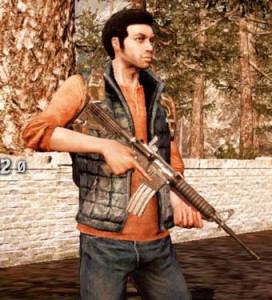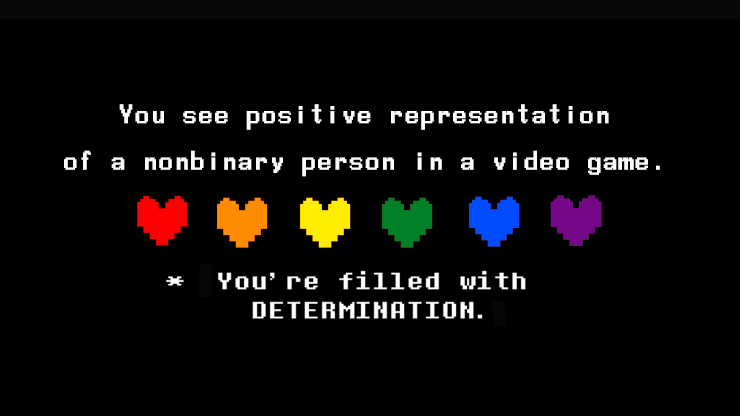Later this week, I’ll also be at Games+Learning+Society with Alex and Kishonna, presenting a Well Played of my own on State of Decay. I’ve been such a strong advocate for the game through two releases (and DLC), but here I’ll finally be able to draw the various themes and lines of inquiry I’ve pursued together into one idea: State of Decay as a model of feminist game design. This isn’t to say that Undead Labs’ zombie game is a paragon of feminist ideals; even though I love it, I’ll be the first to admit State of Decay isn’t perfect on any level, much less as a feminist experience. What I will say (on Friday, in fact) is that there’s something very special about the design of this game that sets it apart. It’s not the forwarding of any particular overt agenda. It’s not the gamespace or the combination of content and mechanics. It’s not really anything about the game itself, but rather, particular decisions that were made by the development team at key moments, which is why I’m not necessarily talking about State of Decay as a feminist game (though I think it is), but as a model for feminist game design.
So what is this special factor that makes SoD a unique model of game design? After all, I’ve analyzed the characters a variety of ways only to discover the game wasn’t quite as diverse as it felt (though still offers a broad range of characters, particularly compared to many action-oriented games). But it turns out it’s not the numbers, but the deployment of characters, the construction of the world, that makes this game a standout. In a world in which we are constantly asked what gender or race or body type matters if the character is good, the team at Undead Labs seemingly put that to the test: nearly every character in a leadership position in State of Decay is outside the white/male/cis/hetero norm dominating games.
Oh, this isn’t to say that we don’t see Black men in leadership roles in other games, or women, or other marginalized bodies. Halo’s Sergeant Johnson comes to mind, as do any number of women in the Resident Evil franchise. You can find diverse characters from all over gaming’s history in leadership roles, but here, in this single game, the virtual world is dominated by them: commanding officers Alicia Hawkes and Diane Montressor, Judge Constance Lawton, combat veteran Maya Torres, ex-county commissioner (and son of the former mayor) Ray Santos all hold or held official leadership positions. Unofficially, Lily Ritter guides the player, coordinating mission opportunities; Marcus Campbell, as the first player character, often feels like the “main” character in this ensemble cast. Erik Tan defects and leads military and civilian resistance efforts. Becca Collins is the unofficial leader of the group at the Grange. Each of these characters represents a moment in which the dev teams had to make a decision — who do we put into this role? — and in each of these examples, they chose to populate the game world with something beyond the rugged brown-haired, bestubbled white man that is the staple of video games.
 Some of these decisions fly in the face of tropes as well; starting a horror-styled game with a Black man? Token sacrifice? Not this time; Marcus is a core character, a fan favorite. The white guy is the comic relief sidekick, the first to get bitten (though a bite isn’t a death sentence in this world; he recovers). Sometimes, though, they also invoke stereotypes. I like Ray Santos, but I wonder at the decision to make the Latino a somewhat shady guy with connections and a heart of gold. The known criminal, as revealed by her Breakdown hero label (The Convict), is Sam Hoffman, a Black woman. But these characters are also more than stereotypes. They have stories, feelings, a place in a larger world, even if that world is crumbling, and that focus on the story, on the person, that’s feminist, too. The refusal to let these characters be one-dimensional stereotypes was a feminist decision.
Some of these decisions fly in the face of tropes as well; starting a horror-styled game with a Black man? Token sacrifice? Not this time; Marcus is a core character, a fan favorite. The white guy is the comic relief sidekick, the first to get bitten (though a bite isn’t a death sentence in this world; he recovers). Sometimes, though, they also invoke stereotypes. I like Ray Santos, but I wonder at the decision to make the Latino a somewhat shady guy with connections and a heart of gold. The known criminal, as revealed by her Breakdown hero label (The Convict), is Sam Hoffman, a Black woman. But these characters are also more than stereotypes. They have stories, feelings, a place in a larger world, even if that world is crumbling, and that focus on the story, on the person, that’s feminist, too. The refusal to let these characters be one-dimensional stereotypes was a feminist decision.
These choices reveal the opportunities development teams have for building inclusive game worlds while simply building strong games. The game itself can be a game, not an agenda, but still forward that agenda, by simply demonstrating the kind of thing we are always fighting for more often: diversity in leadership roles. As I write this, my news feeds continue to be filled with commentary on Hillary Clinton’s clothing and smile as she campaigns for President of the United State. I see a slide from a presentation by Dr. Duchess Harris on the identities of professors in the United States: 72% white men. 2% women of color. Slowly, some things are changing, but we can work toward making that change seem less strange, less foreign, by creating worlds that reflect greater diversity, and I think that’s part of what Undead Labs did with State of Decay.
There’s more to this, in terms of game design with this particular title, I think, I a lot more, but I’ll be talking about those other factors during my Well Played on Friday, and will probably revisit the topic here after the presentation.




3 thoughts on “GLS 2016: State of Decay and Feminist Game Design”
A nice read as always!!!
Thanks Alisha, nice article.
I like it as well, very well done. I would look forward to a video of the Well Played(s) that the fine folks at NYM do.